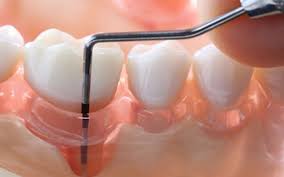Periodontal Treatment
Advanced technology, new comfort
The Sapphire® Portable Diode Laser unit is a dental soft-tissue laser surgical/debridement device.
The Sapphire Portable Diode Laser may be used for a variety of soft-tissue, gingival modification, and sulcular therapy procedures.

The Sapphire Portable Diode Laser is indicated for use in dental intraoral soft tissue general, oral maxilla-facial and cosmetic surgery including ablating, incising, excising, vaporizing and coagulation of soft tissues using a fiber optic delivery system.
Indications include:
• Excision and incision biopsies
• Hemostatic assistance
• Treatment of apthous ulcers
• Gingival incision and excision
• Gingivectomy
• Gingivoplasty
• Gingival troughing
• Gingival recontouring
• Tissue retraction for impressions
• Oral papillectomy
• Sulcular debridement
• Sulcular tissue removal
• Removal of granulation tissue
• Frenectomy
• Frenotomy
• Abcess incision and draining and excision
• Operculectomy
• Removal of fibromas
• Soft tissue crown lengthening
• Vestibuloplasty
How does it work?
Tartar, associated with inflamed and bleeding gums, is removed form the root surface of the tooth using an ultrasonic scaler and small instruments. Then, a small amount of light energy from the Periolase is directed through a tiny fiber, which is gently placed between the gum and tooth.
This laser light energy removes a tiny amount of diseased tissue and aids in reducing the bacteria associated with the disease. After the area is thoroughly cleaned, the body can heal the area naturally.
Does it hurt?
Although the procedure itself can be virtually painless, we anesthetize the area for the patient’s comfort. Post-procedure discomfort is typically minimal and of short duration. See the Periolase Lanap Testimonials.
If you have advanced Periodontal Treatment, treatment may require dental surgery, such as: Flap surgery (pocket reduction surgery). Your periodontist makes tiny incisions in your gum so that a section of gum tissue can be lifted back, exposing the roots for more effective scaling and root planing.
The first nonsurgical step usually involves a special cleaning, called “scaling and root planing,” to remove plaque and tartar deposits on the tooth and root surfaces. This procedure helps gum tissue to heal and Periodontal Treatment pockets to shrink. This is sometimes referred to as “peri- odontal cleaning” or “deep cleaning.”
First of all, there may be a possibility that some of the teeth your husband was told to remove can actually be saved. Periodontal Treatment surgery — including deep cleanings, bone grafting, and splinting and joining of teeth — can do a lot to help people keep their natural teeth when they have periodontal (gum) disease.
Periodontal Treatment is a severe gum infection that can lead to tooth loss and other serious health complications. Periodontal Treatment (per-e-o-don-TIE-tis), also called gum disease, is a serious gum infection that damages the soft tissue and, without treatment, can destroy the bone that supports your teeth.
Periodontal Treatment (gum) disease is an infection of the tissues that hold your teeth in place. It’s typically caused by poor brushing and flossing habits that allow plaque—a sticky film of bacteria—to build up on the teeth and harden.
The bottom line. Receding gums are a common condition. Even with good oral hygiene habits, aging and genetics can still cause gum loss. While your gum tissue can‘t grow back, there are many treatment options that can help stop or slow down the process.
Periodontal Treatment disease or gum disease is not contagious. You can not get gum disease by kissing someone. It is caused by a lack of flossing and poor brushing. Some people are more susceptible to gum disease due to genetics.
Mouthwash can be used to control bad breath and reduce cavities. It can also help to combat conditions such as receding gums, gingivitis, dry mouth, and plaque buildup. Mouthwash should be used in addition to brushing and flossing. It’s important to use a mouthwash that has the ADA Seal of Acceptance.
